Mitigation of CSI Temporal Phase Rotation with B2B Calibration Method for Fine-Grained Motion Detection Analysis on Commodity Wi-Fi Devices
Abstract
1. Introduction
2. Preliminaries and CSI Phase Rotation
2.1. Channel State Information
2.2. Effect of Spatial Diversity and Effective CSI
2.3. CSI Phase Rotation
- Carrier frequency offset (CFO) [2,13,29,36,37,38,39] carrier frequency of the transmitter and receiver are not precisely matched because both are generated from non-synchronized LOs whose frequency offset are independently shifting and varying over time. Consequently, the phase of all CSI subcarriers will suffer from a temporal phase offset .
- Sampling frequency offset (SFO) [2,13,22,29,36,38,39,40] since ADC clocks of the transmitter and receiver are not synchronized, both will drift separately. Therefore, each received signal will experience a time-varying delay offset with respect to the transmitter. In the frequency domain, the offset is represented in the CSI phase as an additional phase rotation proportional to subcarrier index k.
- Packet boundary delay (PBD) [2,13,35,36,37,39,40] after an OFDM symbol passes through the ADC, the receiver estimates the boundary of the OFDM symbol by using correlation detection. The estimated boundary may include a delay offset as long as orthogonality of the OFDM symbol is preserved, and its delay is less than the guard band interval. Similar to SFO, this delay exhibits in the frequency domain as another additional phase rotation proportional to subcarrier index.
- Phase-locked loop offset (PLO) [2,36,37] phase-locked loop circuit is in charge of generating a center frequency for both the transmitter and receiver. As both are using different chips, it will also individually create some initial random phase when the Wi-Fi NIC is initialized causing phase difference to the received OFDM symbol. As a result, CSI phase will be added with a relatively constant phase offset .
3. Phase Rotation Calibration for Motion Detection Analysis
3.1. CSI Calibration Model
3.2. Motion Detection Analysis
4. Experiment and Evaluation
4.1. Experimental Setup
4.2. Evaluation of the CSI Calibration Model
4.3. Motion Detection Analysis with Wavelet Transform
5. Conclusions
Author Contributions
Funding
Conflicts of Interest
References
- Qian, K.; Wu, C.; Zhou, Z.; Zheng, Y.; Yang, Z.; Liu, Y. Inferring Motion Direction using Commodity Wi-Fi for Interactive Exergames. In Proceedings of the 2017 CHI Conference on Human Factors in Computing Systems, Denver, CO, USA, 6–11 May 2017; pp. 1961–1972. [Google Scholar]
- Wang, X.; Yang, C.; Mao, S. PhaseBeat: Exploiting CSI Phase Data for Vital Sign Monitoring with Commodity WiFi Devices. In Proceedings of the 2017 IEEE 37th International Conference on Distributed Computing Systems (ICDCS), Atlanta, GA, USA, 5–8 June 2017; pp. 1230–1239. [Google Scholar]
- Yousefi, S.; Narui, H.; Dayal, S.; Ermon, S.; Valaee, S. A Survey on Behavior Recognition Using WiFi Channel State Information. IEEE Commun. Mag. 2017, 55, 98–104. [Google Scholar] [CrossRef]
- Wu, D.; Zhang, D.; Xu, C.; Wang, H.; Li, X. Device-Free WiFi Human Sensing: From Pattern-Based to Model-Based Approaches. IEEE Commun. Mag. 2017, 55, 91–97. [Google Scholar] [CrossRef]
- Kellogg, B.; Talla, V.; Gollakota, S. Bringing Gesture Recognition To All Devices. In Proceedings of the 11th USENIX Conference on Networked Systems Design and Implementation (NSDI 14), Seattle, WA, USA, 2–4 April 2014; pp. 303–316. [Google Scholar]
- Archasantisuk, S.; Aoyagi, T.; Uusitupa, T.; Kim, M.; Takada, J.i. Human Motion Classification Using Radio Signal Strength in WBAN. IEICE Trans. Commun. 2016, E99.B, 592–601. [Google Scholar] [CrossRef]
- Abdelnasser, H.; Youssef, M.; Harras, K.A. WiGest: A Ubiquitous WiFi-based Gesture Recognition System. In Proceedings of the 2015 IEEE Conference on Computer Communications (INFOCOM), Hong Kong, China, 26 April–1 May 2015; Volume 26, pp. 1472–1480. [Google Scholar]
- Patwari, N.; Brewer, L.; Tate, Q.; Kaltiokallio, O.; Bocca, M. Breathfinding: A wireless network that monitors and locates breathing in a home. IEEE J. Sel. Top. Signal Process. 2014, 8, 30–42. [Google Scholar] [CrossRef]
- Sandoval, R.M.; Garcia-Sanchez, A.J.; Garcia-Haro, J. Improving RSSI-based path-loss models accuracy for critical infrastructures: A smart grid substation case-study. IEEE Trans. Ind. Inform 2018, 14, 2230–2240. [Google Scholar] [CrossRef]
- Lui, G.; Gallagher, T.; Li, B.; Dempster, A.G.; Rizos, C. Differences in RSSI readings made by different Wi-Fi chipsets: A limitation of WLAN localization. In Proceedings of the 2011 International Conference on Localization and GNSS (ICL-GNSS), Tampere, Finland, 29–30 June 2011; pp. 53–57. [Google Scholar]
- Boano, C.A.; Wennerström, H.; Zúñiga, M.A.; Brown, J.; Keppitiyagama, C.; Oppermann, F.J.; Roedig, U.; Nordén, L.Å.; Voigt, T.; Römer, K. Hot Packets: A Systematic Evaluation of the Effect of Temperature on Low Power Wireless Transceivers. In Proceedings of the Extreme Conference on Communication, Association of Computing Machinery, Eyjafjallajökull Volcano, Iceland, 24–29 August 2013; pp. 7–12. [Google Scholar]
- Halperin, D.; Hu, W.; Sheth, A.; Wetherall, D. Tool Release: Gathering 802.11n Traces with Channel State Information. ACM SIGCOMM Comput. Commun. Rev. 2011, 41, 53. [Google Scholar] [CrossRef]
- Xie, Y.; Li, Z.; Li, M. Precise Power Delay Profiling with Commodity WiFi. In Proceedings of the 21st Annual International Conference on Mobile Computing and Networking, Paris, France, 7–11 September 2015; pp. 53–64. [Google Scholar]
- Wang, W.; Liu, A.X.; Shahzad, M.; Ling, K.; Lu, S. Device-Free Human Activity Recognition Using Commercial WiFi Devices. IEEE J. Sel. Areas Commun. 2017, 35, 1118–1131. [Google Scholar] [CrossRef]
- Sen, S.; Radunovic, B.; Choudhury, R.R.; Minka, T. You are Facing the Mona Lisa: Spot Localization using PHY Layer Information Souvik. In Proceedings of the 10th International Conference on Mobile Systems, Applications, and Services, Lake District, UK, 25–29 June 2012; p. 183. [Google Scholar]
- Zhang, J.; Wei, B.; Hu, W.; Kanhere, S.S. WiFi-ID: Human Identification using WiFi signal. In Proceedings of the 2016 International Conference on Distributed Computing in Sensor Systems (DCOSS), Washington, DC, USA, 26–28 May 2016; pp. 75–82. [Google Scholar]
- Zheng, X.; Wang, J.; Shangguan, L.; Zhou, Z.; Liu, Y. Smokey: Ubiquitous smoking detection with commercial WiFi infrastructures. In Proceedings of the IEEE INFOCOM 2016—The 35th Annual IEEE International Conference on Computer Communications, San Francisco, CA, USA, 10–14 April 2016; pp. 1–9. [Google Scholar]
- Li, H.; Yang, W.; Wang, J.; Xu, Y.; Huang, L. WiFinger: Talk to Your Smart Devices with Finger-grained Gesture. In Proceedings of the 2016 ACM International Joint Conference on Pervasive and Ubiquitous Computing, Heidelberg, Germany, 12–16 September 2016; pp. 250–261. [Google Scholar]
- Ali, K.; Liu, A.X.; Wang, W.; Shahzad, M. Keystroke Recognition Using WiFi Signals. In Proceedings of the 21st Annual International Conference on Mobile Computing and Networking, Paris, France, 7–11 September 2015; pp. 90–102. [Google Scholar]
- Tan, S.; Yang, J. WiFinger: Leveraging commodity WiFi for fine-grained finger gesture recognition. In Proceedings of the 17th ACM International Symposium on Mobile Ad Hoc Networking and Computing, Paderborn, Germany, 5–8 July 2016; pp. 201–210. [Google Scholar]
- Wu, C.; Yang, Z.; Zhou, Z.; Qian, K.; Liu, Y.; Liu, M. PhaseU: Real-time LOS Identification with WiFi. In Proceedings of the 2015 IEEE Conference on Computer Communications (INFOCOM), Hong Kong, China, 26 April–1 May 2015; pp. 2038–2046. [Google Scholar]
- Gong, L.; Yang, W.; Man, D.; Dong, G.; Yu, M.; Lv, J. WiFi-based real-time calibration-free passive human motion detection. Sensors 2015, 15, 32213–32229. [Google Scholar] [CrossRef] [PubMed]
- IEEE Standard for Information technology– Local and metropolitan area networks– Specific requirements– Part 11: Wireless LAN Medium Access Control (MAC)and Physical Layer (PHY) Specifications Amendment 5: Enhancements for Higher Throughput. In IEEE Std 802.11n-2009; IEEE: Piscataway, NJ, USA, 2009; pp. 1–565.
- Halperin, D.C. Simplifying the Configuration of 802.11 Wireless Networks with Effective SNR. Ph.D. Thesis, University of Washington, Washington, DC, USA, 2012. [Google Scholar]
- Liu, X.; Cao, J.; Tang, S.; Wen, J. Wi-sleep: Contactless sleep monitoring via WiFi signals. In Proceedings of the 2014 IEEE Real-Time Systems Symposium, Rome, Italy, 2–5 December 2014; pp. 346–355. [Google Scholar]
- Liu, J.; Wang, Y.; Chen, Y.; Yang, J.; Chen, X.; Cheng, J. Tracking Vital Signs During Sleep Leveraging Off-the-shelf WiFi. In Proceedings of the 16th ACM International Symposium on Mobile Ad Hoc Networking and Computing, Hangzhou, China, 22–25 June 2015; pp. 267–276. [Google Scholar]
- Wang, G.; Zou, Y.; Zhou, Z.; Wu, K.; Ni, L.M. We Can Hear You with Wi-Fi! IEEE Trans. Mob. Comput. 2016, 15, 2907–2920. [Google Scholar] [CrossRef]
- Wang, Y.; Jiang, X.; Cao, R.; Wang, X. Robust Indoor Human Activity Recognition Using Wireless Signals. Sensors 2015, 15, 17195–17208. [Google Scholar] [CrossRef] [PubMed]
- Wang, X.; Gao, L.; Mao, S. CSI Phase Fingerprinting for Indoor Localization with a Deep Learning Approach. IEEE Internet Things J. 2016, 3, 1113–1123. [Google Scholar] [CrossRef]
- Gong, L.; Man, D.; Lv, J.; Shen, G.; Yang, W. FRID: Indoor Fine-Grained Real-Time Passive Human Motion Detection. In Proceedings of the 2015 IEEE 12th International Conference on Ubiquitous Intelligence and Computing and 2015 IEEE 12th International Conference on Autonomic and Trusted Computing and 2015 IEEE 15th International Conference on Scalable Computing and Communications and Its Associated Workshops (UIC-ATC-ScalCom), Beijing, China, 10–14 August 2015; pp. 308–311. [Google Scholar]
- Zhang, D.; Wang, H.; Wang, Y.; Ma, J. Anti-fall: A non-intrusive and real-time fall detector leveraging CSI from commodity WIFI devices. Lect. Notes Comput. Sci. 2015, 9102, 181–193. [Google Scholar]
- Wang, X.; Yang, C.; Mao, S. TensorBeat: Tensor Decomposition for Monitoring Multi-Person Breathing Beats with Commodity WiFi. ACM Trans. Intell. Syst. Technol. 2017, 9, 1–28. [Google Scholar]
- Skolnik, M.I. Radar Handbook; McGraw-Hill Education: New York, NY, USA, 2008; p. 1328. [Google Scholar]
- Borhani, A.; Patzold, M. A Non-Stationary Channel Model for the Development of Non-Wearable Radio Fall Detection Systems. IEEE Trans. Wirel. Commun. 2018. [Google Scholar] [CrossRef]
- Qian, K.; Wu, C.; Yang, Z.; Zhou, Z.; Wang, X.; Liu, Y. Tuning by turning: Enabling phased array signal processing for WiFi with inertial sensors. In Proceedings of the IEEE INFOCOM 2016—The 35th Annual IEEE International Conference on Computer Communications, San Francisco, CA, USA, 10–14 April 2016; pp. 1–9. [Google Scholar]
- Zhuo, Y.; Zhu, H.; Xue, H. Identifying a New Non-linear CSI Phase Measurement Error with Commodity WiFi Devices. In Proceedings of the 2016 IEEE 22nd International Conference on Parallel and Distributed Systems (ICPADS), Wuhan, China, 13–16 December 2017; pp. 72–79. [Google Scholar]
- Vasisht, D.; Kumar, S.; Katabi, D. Decimeter-Level Localization with a Single WiFi Access Point. In Proceedings of the 13th Usenix Conference on Networked Systems Design and Implementation, Santa Clara, CA, USA, 16–18 March 2016; pp. 165–178. [Google Scholar]
- Mahfoudi, M.N.; Turletti, T.; Parmentelat, T.; Ferrero, F.; Lizzi, L.; Staraj, R.; Dabbous, W.; Mahfoudi, M.N.; Turletti, T.; Parmentelat, T.; et al. ORION: Orientation Estimation Using Commodity Wi-Fi. In Proceedings of the 2017 IEEE International Conference on Communications Workshops (ICC Workshops), Paris, France, 21–25 May 2017; pp. 1033–1038. [Google Scholar]
- Speth, M.; Fechtel, S.; Fock, G.; Meyr, H. Optimum Receiver Design for Wireless Broad-Band Systems Using OFDM—Part I. IEEE Trans. Commun. 1999, 47, 1668–1677. [Google Scholar] [CrossRef]
- Kotaru, M.; Joshi, K.; Bharadia, D.; Katti, S. SpotFi: Decimeter Level Localization Using WiFi. In Proceedings of the 2015 ACM Conference on Special Interest Group on Data Communication, London, UK, 17–21 August 2015; Volume 45, pp. 269–282. [Google Scholar]
- Tsao, T.; Slamani, M.; Varshney, P.; Weiner, D.; Schwarzlander, H.; Borek, S. Ambiguity function for a bistatic radar. IEEE Trans. Aerosp. Electron. Syst. 1997, 33, 1041–1051. [Google Scholar] [CrossRef]
- Molisch, A.F. Wireless Communications, 2nd ed.; Wiley-IEEE Press: West Sussex, UK, 2010; p. 884. [Google Scholar]
- Stéphane, M. A Wavelet Tour of Signal Processing: The Sparse Way; Academic Press: Cambridge, MA, USA, 2009; p. 805. [Google Scholar]
- Jordan, D.; Miksad, R.W.; Powers, E.J. Implementation of the continuous wavelet transform for digital time series analysis. Rev. Sci. Instrum. 1997, 68, 1484. [Google Scholar] [CrossRef]
- Matani, A.; Oshiro, O.; Chihara, K. Doppler Signal Processing of Blood Flow Using a Wavelet Transform. Jpn. J. Appl. Phys. 1996, 35, 3131–3134. [Google Scholar] [CrossRef]
- Aydin, N.; Markus, H.S. Wavelet Analysis of Quadrature Doppler Ultrasound Signals. In Proceedings of the 2000 First International Conference Advances in Medical Signal and Information Processing, Bristol, UK, 4–6 September 2000; pp. 251–256. [Google Scholar]
- Steven, E.; Noel, H.H.; Szu, Y.J.G. Doppler frequency estimation with wavelets and neural networks. In Proceedings of the International Society for Optics and Photonics 3391, Wavelet Applications V, Orlando, FL, USA, 26 March 1998; pp. 150–157. [Google Scholar]
- Plamondon, R.; Alimi, A.M.; Yergeau, P.; Leclerc, F. Modelling velocity profiles of rapid movements: A comparative study. Biol. Cybern. 1993, 69, 119–128. [Google Scholar] [CrossRef] [PubMed]
- Flash, T.; Hogans, N. The Coordination of Arm Movements: An Experimentally Confirmed Mathematical Model. J. Neurosci. 1985, 5, 1688–1703. [Google Scholar] [CrossRef] [PubMed]
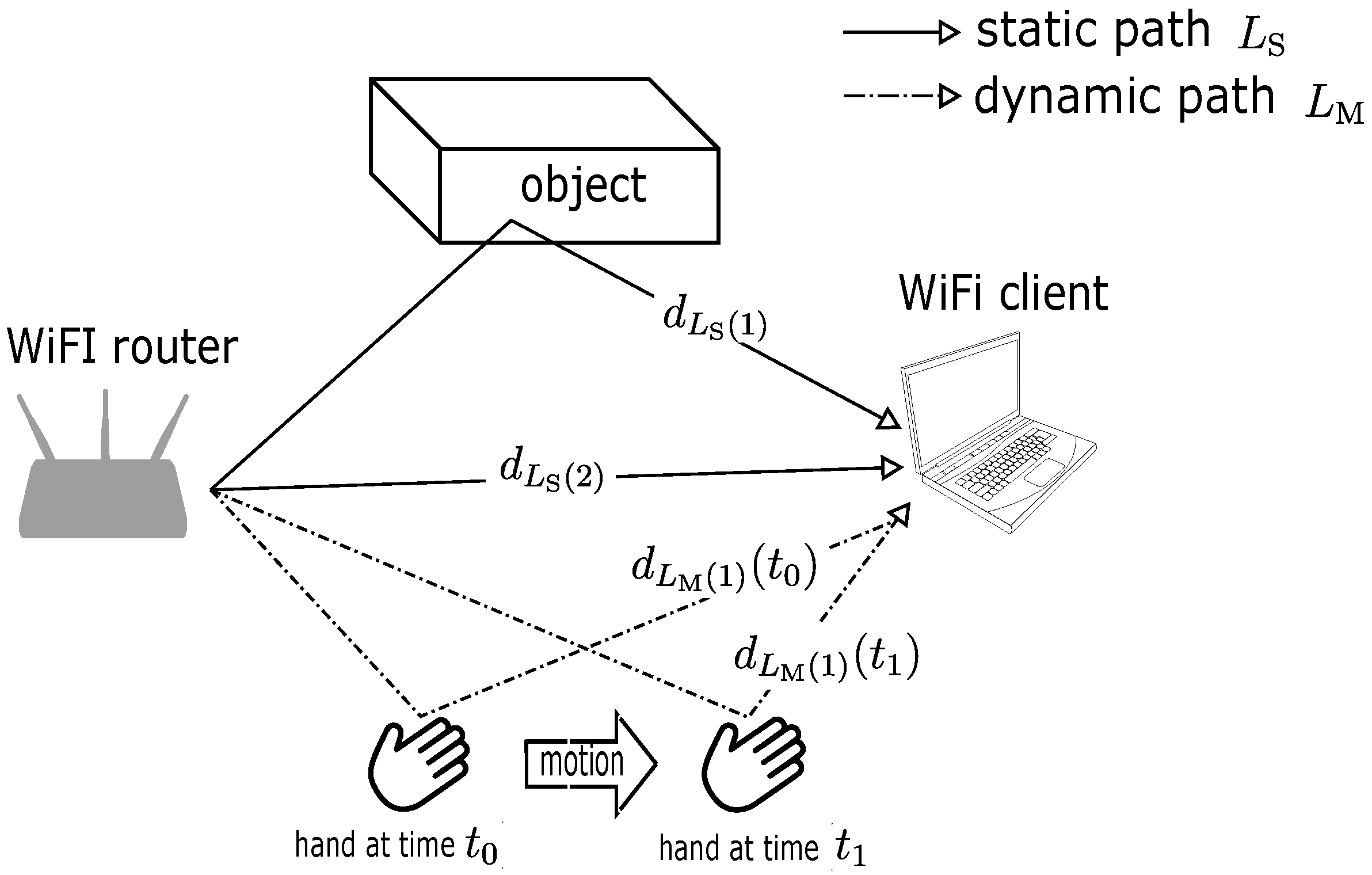


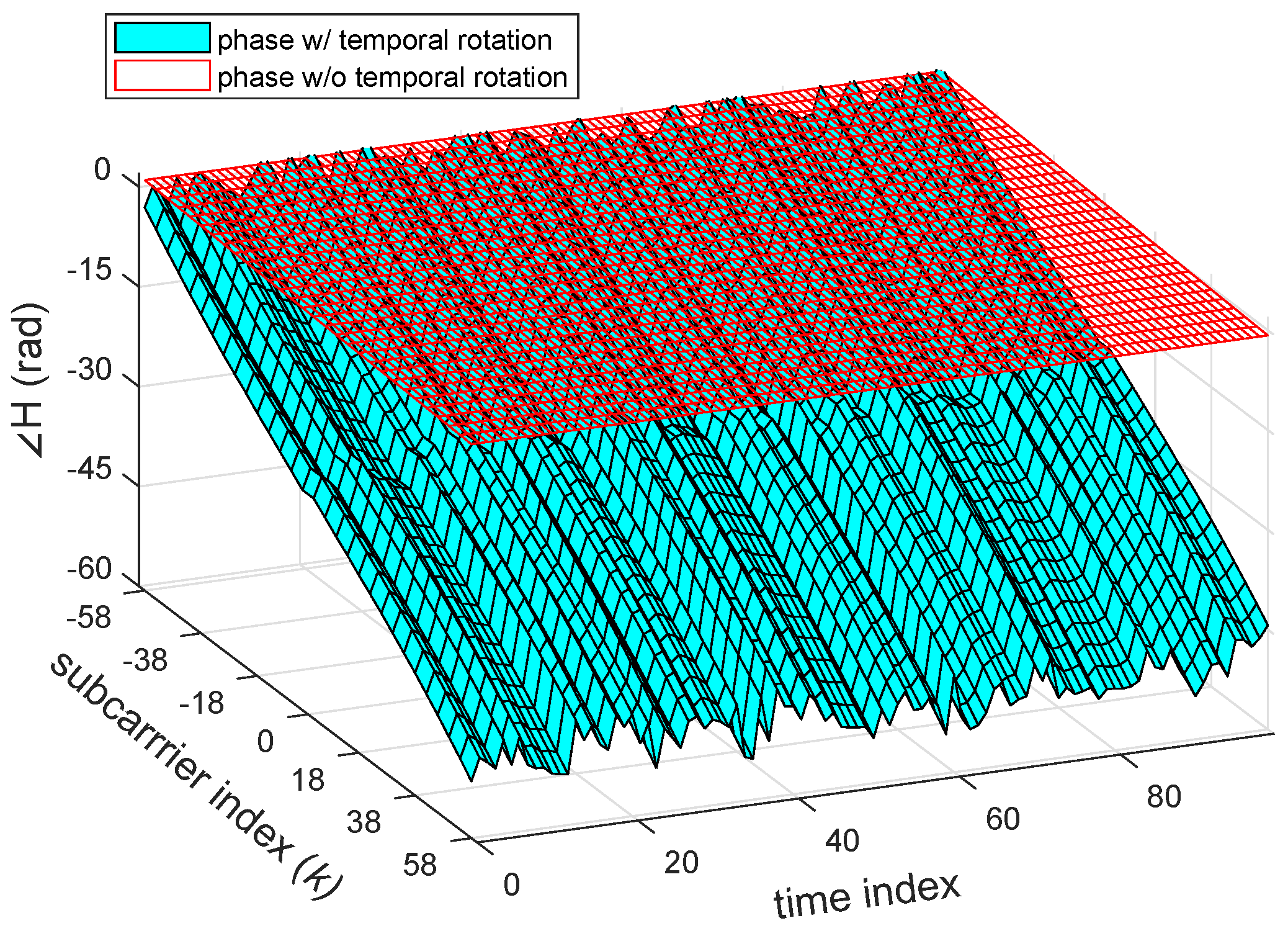

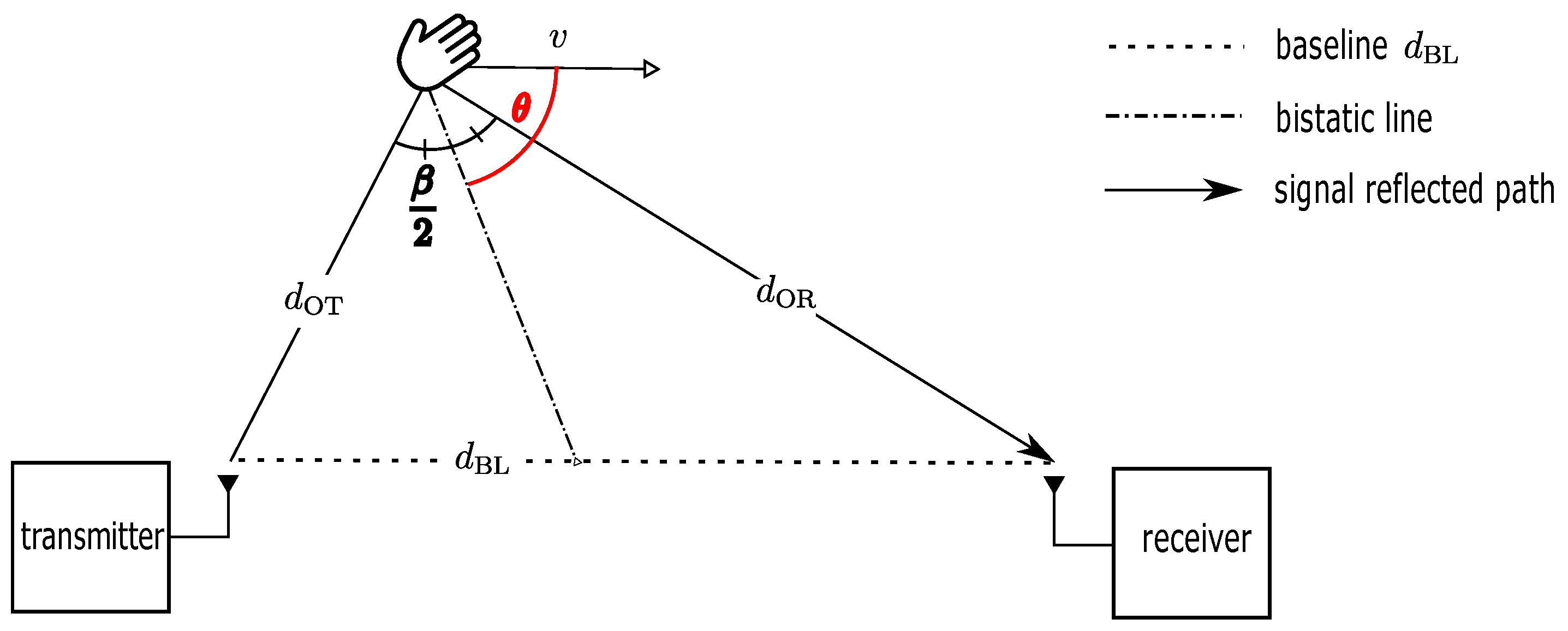

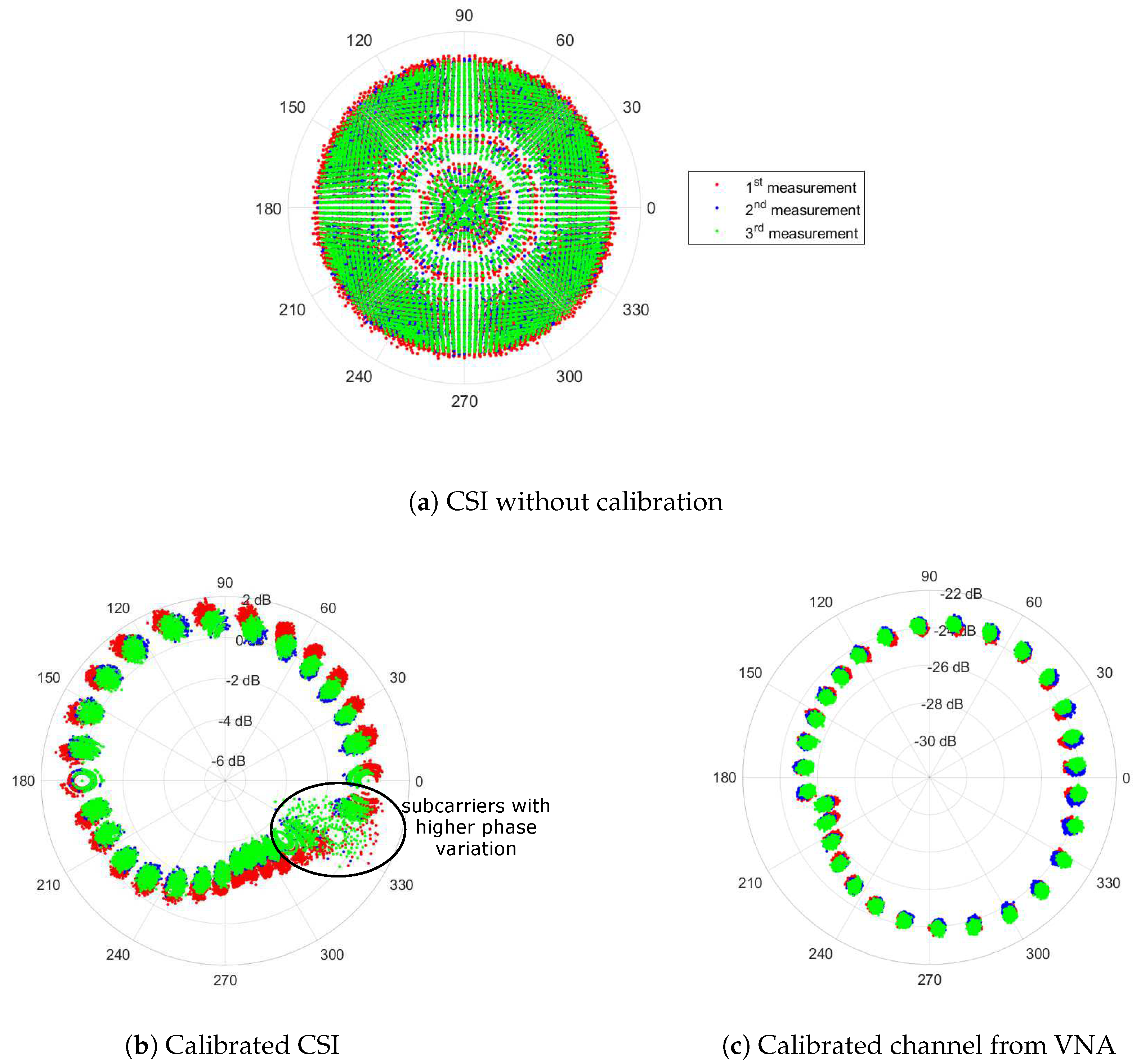

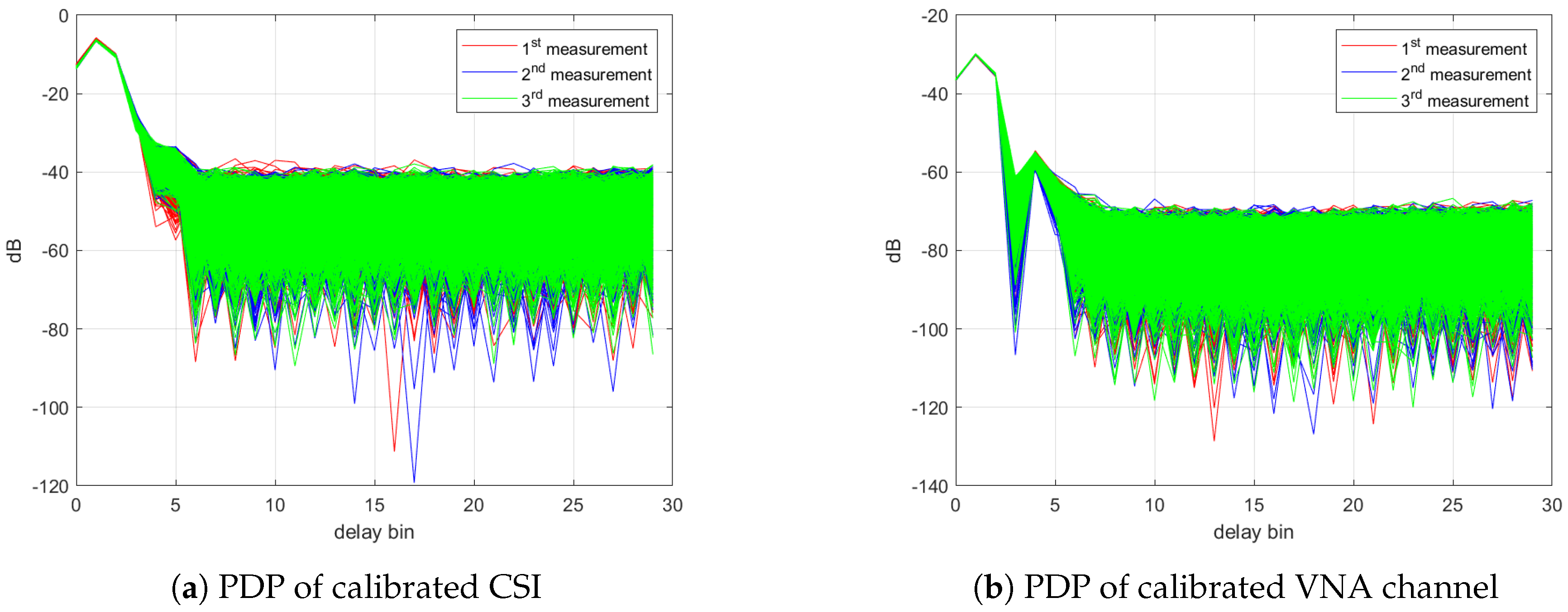
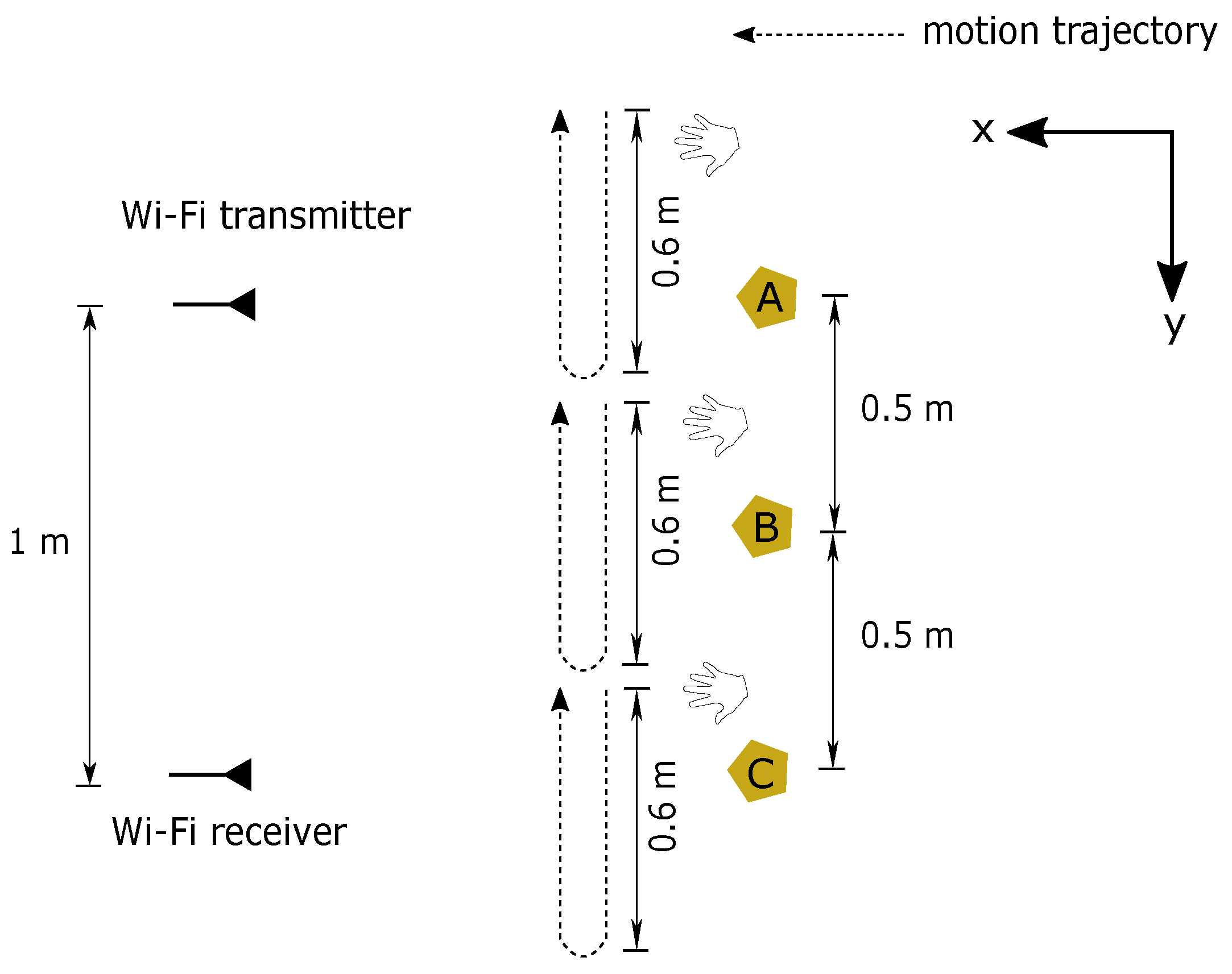
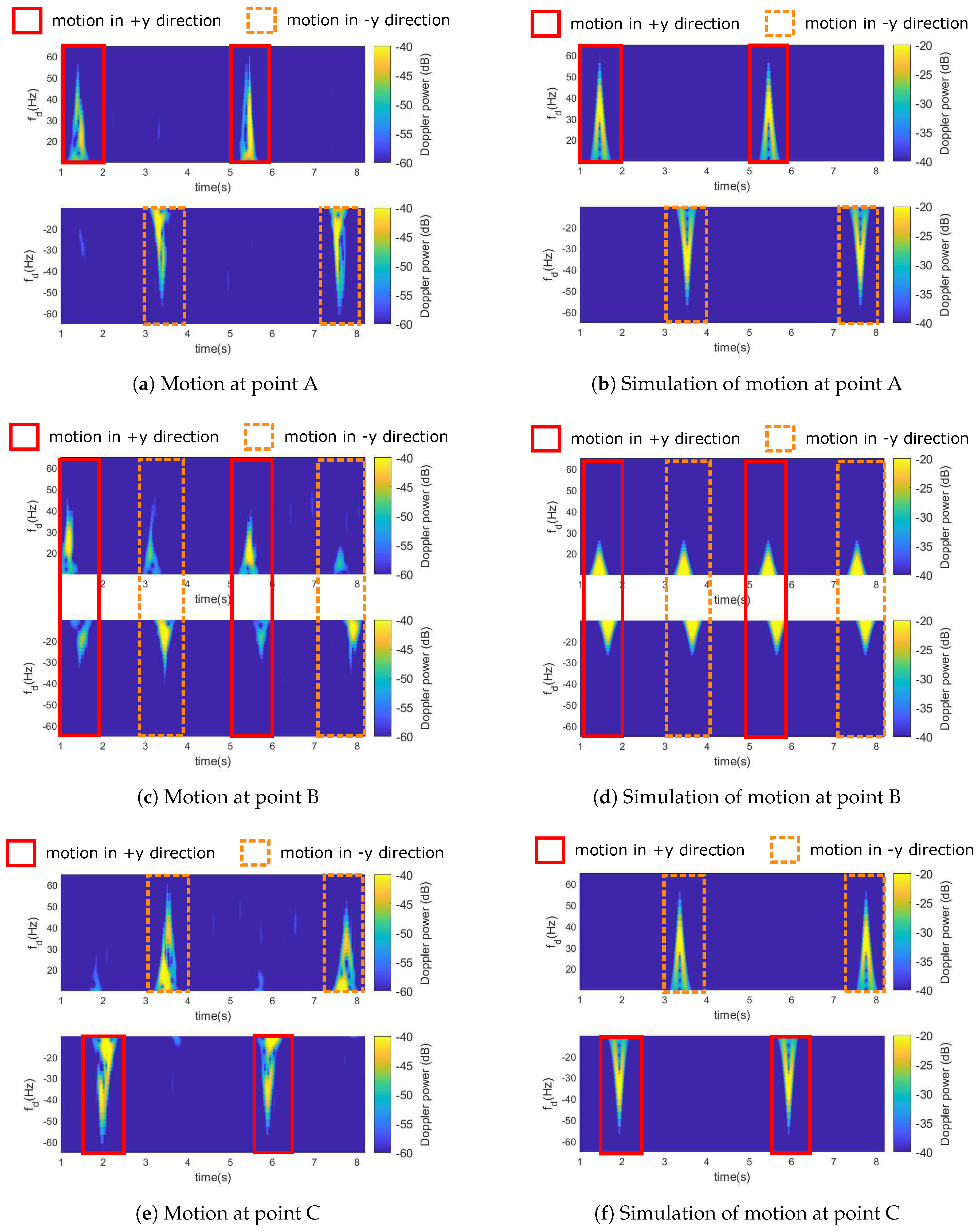
© 2018 by the authors. Licensee MDPI, Basel, Switzerland. This article is an open access article distributed under the terms and conditions of the Creative Commons Attribution (CC BY) license (http://creativecommons.org/licenses/by/4.0/).
Share and Cite
Keerativoranan, N.; Haniz, A.; Saito, K.; Takada, J.-i. Mitigation of CSI Temporal Phase Rotation with B2B Calibration Method for Fine-Grained Motion Detection Analysis on Commodity Wi-Fi Devices. Sensors 2018, 18, 3795. https://doi.org/10.3390/s18113795
Keerativoranan N, Haniz A, Saito K, Takada J-i. Mitigation of CSI Temporal Phase Rotation with B2B Calibration Method for Fine-Grained Motion Detection Analysis on Commodity Wi-Fi Devices. Sensors. 2018; 18(11):3795. https://doi.org/10.3390/s18113795
Chicago/Turabian StyleKeerativoranan, Nopphon, Azril Haniz, Kentaro Saito, and Jun-ichi Takada. 2018. "Mitigation of CSI Temporal Phase Rotation with B2B Calibration Method for Fine-Grained Motion Detection Analysis on Commodity Wi-Fi Devices" Sensors 18, no. 11: 3795. https://doi.org/10.3390/s18113795
APA StyleKeerativoranan, N., Haniz, A., Saito, K., & Takada, J.-i. (2018). Mitigation of CSI Temporal Phase Rotation with B2B Calibration Method for Fine-Grained Motion Detection Analysis on Commodity Wi-Fi Devices. Sensors, 18(11), 3795. https://doi.org/10.3390/s18113795




